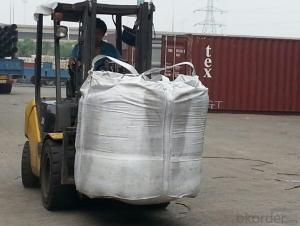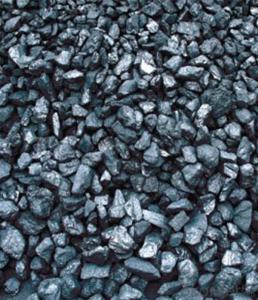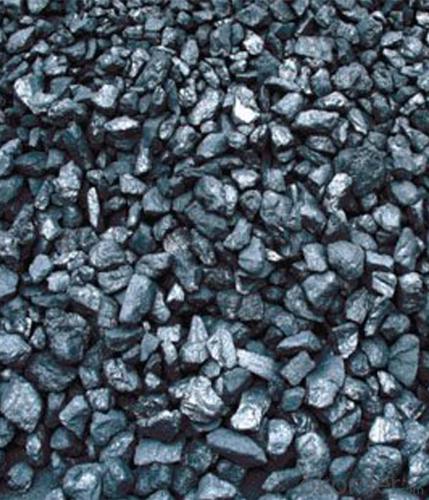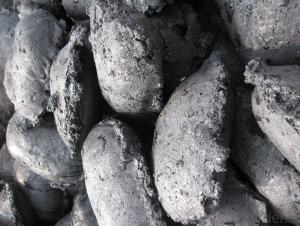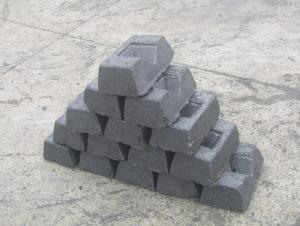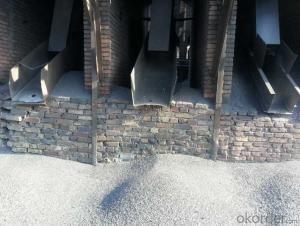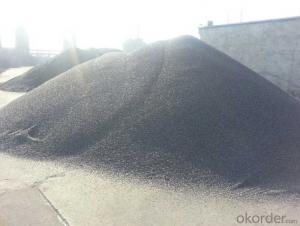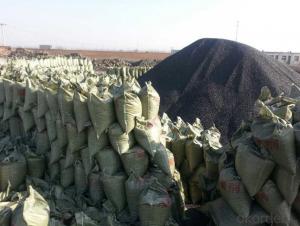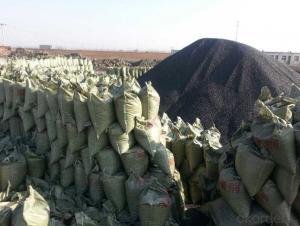Charge Coke FC92 with high and stable quality
- Loading Port:
- Tianjin
- Payment Terms:
- TT OR LC
- Min Order Qty:
- 20 m.t.
- Supply Capability:
- 3000 m.t./month
OKorder Service Pledge
OKorder Financial Service
You Might Also Like
Packaging & Delivery
25kgs/50kgs/1ton per bag or as buyer's request
Specifications
Calcined Anthracite
Fixed carbon: 90%-95%
S: 0.5% max
Size: 0-3. 3-5.3-15 or as request
It used the high quality anthracite as raw materials through high temperature calcined at over 2000 by the DC electric calciner with results in eliminating the moisture and volatile matter from anthracite efficiently, improving the density and the electric conductivity and strengthening the mechanical strength and anti-oxidation. It has good characteristics with low ash, low resistvity, low sulphur, high carbon and high density. It is the best material for high quality carbon products.
Advantage and competitive of caclined anthracite:
1. strong supply capability
2. fast transportation
3. lower and reasonable price for your reference
4.low sulphur, low ash
5.fixed carbon:95% -90%
6..sulphur:lower than 0.3%
General Specification of Calcined Anthracite:
| FC | 95 | 94 | 93 | 92 | 90 |
| ASH | 4 | 5 | 6 | 6.5 | 8.5 |
| V.M. | 1 | 1 | 1 | 1.5 | 1.5 |
| S | 0.3 | 0.3 | 0.3 | 0.35 | 0.35 |
| MOISTURE | 0.5 | 0.5 | 0.5 | 0.5 | 0.5 |
Pictures
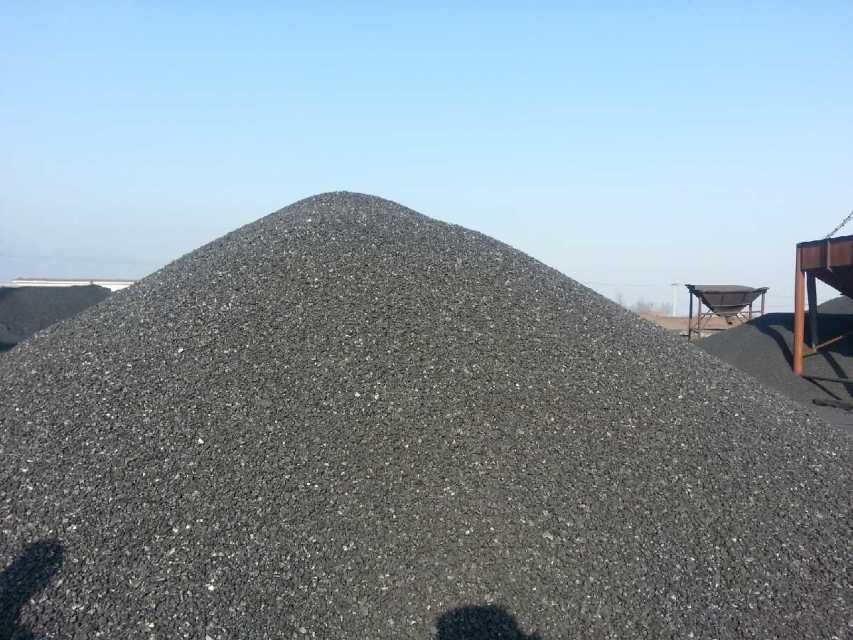
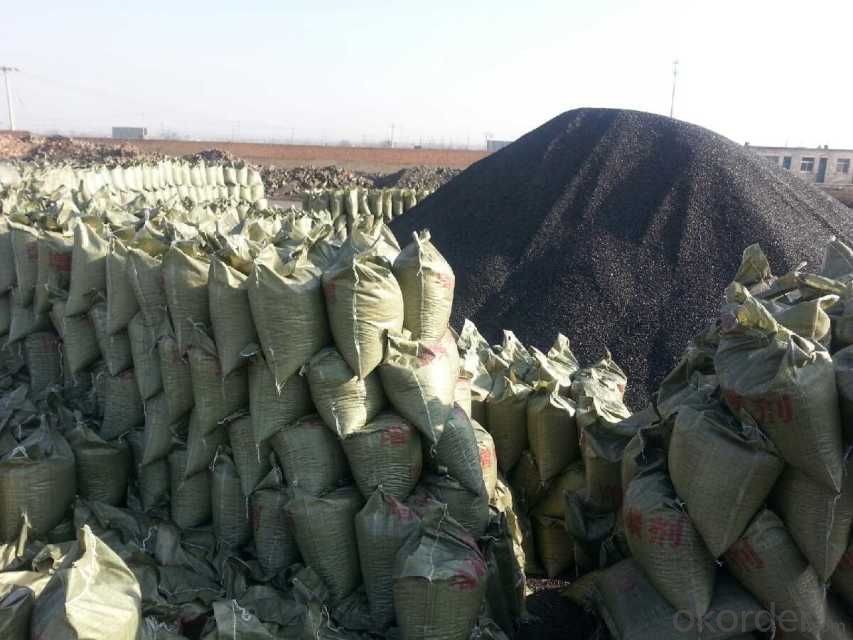
- Q: What are the consequences of increased carbon emissions on technological advancements?
- The consequences of increased carbon emissions on technological advancements can be both positive and negative. On one hand, the increased focus on reducing carbon emissions has spurred innovation in clean technology and renewable energy sources. This has led to advancements in technologies such as solar panels, wind turbines, and electric vehicles, which are considered more environmentally friendly alternatives to traditional energy sources. These advancements have the potential to create new industries, generate jobs, and promote sustainable development. On the other hand, increased carbon emissions can have negative consequences on technological advancements. The rising levels of carbon dioxide in the atmosphere contribute to climate change, which poses significant challenges to various sectors, including technology. Extreme weather events, such as hurricanes and wildfires, can damage infrastructure and disrupt technological systems. In addition, higher temperatures can affect the efficiency of electronic devices, leading to increased energy consumption and reduced performance. Furthermore, the need to mitigate and adapt to climate change through the development of clean technologies requires significant financial investments. This can divert resources from other areas of technological innovation and research, limiting advancements in fields such as artificial intelligence, biotechnology, or space exploration. As a result, the focus on addressing carbon emissions may reduce the overall pace of progress in certain technological areas. Overall, the consequences of increased carbon emissions on technological advancements are complex and multifaceted. While they have driven innovation in clean technologies, they have also presented challenges and trade-offs in terms of resource allocation and the impact of climate change on technological infrastructure. Efforts to reduce carbon emissions need to be balanced with ensuring continued progress in other technological fields to achieve a sustainable and technologically advanced future.
- Q: What are the impacts of carbon emissions on the stability of savannas?
- Carbon emissions have significant impacts on the stability of savannas, which are delicate and diverse ecosystems. One of the main consequences of carbon emissions is the increase in greenhouse gases, such as carbon dioxide, in the atmosphere. This leads to global warming, which has several direct and indirect effects on savannas. Firstly, higher temperatures resulting from global warming can alter the natural fire regimes in savannas. These ecosystems are adapted to periodic fires, which play a crucial role in maintaining their structure and biodiversity. However, increased temperatures can intensify and prolong fire seasons, leading to more frequent and intense wildfires. This can disrupt the natural balance, causing the loss of vegetation, changes in species composition, and reducing the overall stability of the savanna ecosystem. Secondly, elevated carbon dioxide levels can affect the physiology and growth of plants. While some studies suggest that increased CO2 concentrations may enhance plant productivity in savannas, it is important to consider other factors such as nutrient availability and water availability. If these factors do not keep pace with increased carbon dioxide levels, the positive effects on plant growth may be limited, leading to imbalances in the ecosystem. Furthermore, carbon emissions contribute to climate change, which alters rainfall patterns and distribution. Savannas rely on a delicate balance between wet and dry seasons. Changes in precipitation patterns can disrupt this balance, affecting the availability of water for plants and animals. This can lead to shifts in species distribution, reduced habitat suitability, and increased competition for limited resources, further destabilizing the savanna ecosystem. Lastly, carbon emissions also contribute to ocean acidification, which affects marine ecosystems. Coral reefs, which are interconnected with savannas through coastal regions, provide essential habitat and protection for many marine species. Acidic waters can harm coral reefs, leading to their decline and subsequent loss of biodiversity in savanna ecosystems. In conclusion, carbon emissions have significant impacts on the stability of savannas. Global warming, changes in fire regimes, altered precipitation patterns, and ocean acidification all affect the delicate balance and biodiversity of these ecosystems. It is crucial to address carbon emissions and mitigate their effects to ensure the long-term stability and conservation of savannas and the services they provide.
- Q: Will long-term use of carbon alloy chopsticks cause cancer?
- Do chopsticks also cause cancer? Experts say, should not use too long, 3 to 6 months that change, pay attention to chopsticks material selection, use and maintenance. Have you noticed how often the chopsticks are changed at home? Recently, a news about the need for regular replacement of chopsticks, attracted the attention of Internet users. According to reports, hidden in the small groove in the chopsticks bacteria, may cause dysentery, gastroenteritis and other diseases, it is recommended that the public, chopsticks should be replaced at regular intervals of 3~6 months. This makes many people surprised, "used so many years chopsticks, do not know!"." Yesterday morning, in the south near Xi'an Renrenle supermarket shopping public Ms. Hao said. Subsequently, a random survey of 20 members of the public, of which 4 people said that in the six months of internal moving or kitchen renovation and replaced chopsticks. While the other 16 citizens, the number of chopsticks used in the home was 1~3 years. Especially for families with old people, chopsticks are updated more slowly. "The old man can't bear to throw it. He can't help it. Every time he comes to the restaurant, the chopsticks are not enough."." Liu said the public. In this regard, yesterday, director of the Xi'an Municipal Hospital of traditional Chinese Medicine Department of Gastroenterology physician Huang Yahui said, if the wood and bamboo chopsticks used for a long time, it is easy to breed bacteria sawdust loose.
- Q: What is the role of carbon in the formation of fossil fuels?
- The role of carbon in the formation of fossil fuels is crucial. Fossil fuels, such as coal, oil, and natural gas, are formed from the remains of ancient plants and organisms that lived millions of years ago. These organisms were primarily made up of carbon-based compounds. Over time, the organic matter accumulated and was buried under layers of sediment, subjected to intense heat and pressure. This process, known as carbonization, caused the carbon within the organic matter to undergo chemical changes, transforming it into fossil fuels. Therefore, carbon is the key element involved in the formation of fossil fuels.
- Q: How do fossil fuels release carbon into the atmosphere?
- Fossil fuels release carbon into the atmosphere through the process of combustion. When fossil fuels like coal, oil, and natural gas are burned for energy production, carbon dioxide (CO2) is released as a byproduct. This CO2 is a greenhouse gas that traps heat in the Earth's atmosphere, contributing to global warming and climate change.
- Q: How is carbon dating used to determine the age of fossils?
- Carbon dating is a scientific method that scientists use to figure out how old fossils and other organic materials are. It works because there is a special type of carbon called carbon-14 that is in the air and gets absorbed by living things when they're alive. When an organism dies, it stops taking in carbon-14 and the amount of it starts to go down over time as it breaks down. To find out the age of a fossil using carbon dating, scientists first take a small piece of the fossil. They then treat this piece with chemicals to get rid of any impurities and get the carbon out of the organic material. The carbon that is extracted is then turned into carbon dioxide gas, which is used to make graphite targets for measuring the levels of carbon-14. Scientists use a technique called Accelerator Mass Spectrometry (AMS) to count how many carbon-14 and carbon-12 atoms are in the sample. They then use the ratio of carbon-14 to carbon-12 to figure out how old the fossil is, based on the known half-life of carbon-14, which is about 5730 years. By comparing the amount of carbon-14 left in the fossil to the amount of carbon-14 in the air when the organism died, scientists can estimate the approximate age of the fossil. This method is especially useful for dating organic materials that are up to around 50,000 years old. For older fossils, scientists usually use other methods like potassium-argon dating or uranium-lead dating.
- Q: How does carbon impact the formation of smog?
- Carbon plays a significant role in the formation of smog, particularly in the form of carbon monoxide (CO) and volatile organic compounds (VOCs). When fossil fuels are burned, such as in vehicle engines or power plants, they release carbon monoxide into the atmosphere. Carbon monoxide is a colorless and odorless gas that can react with other pollutants in the presence of sunlight to form ground-level ozone, a key component of smog. Furthermore, carbon-based compounds known as volatile organic compounds (VOCs) are also emitted from various sources, including industrial processes, gasoline vapors, and chemical solvents. These VOCs can undergo chemical reactions in the presence of nitrogen oxides and sunlight to create ground-level ozone as well. Both carbon monoxide and VOCs contribute to the formation of smog by reacting with nitrogen oxides (NOx) in the presence of sunlight. This chemical reaction forms ground-level ozone, which is a primary component of smog. Ozone is harmful to human health and the environment, and its formation is exacerbated by the presence of carbon emissions. Reducing carbon emissions is crucial to mitigating the formation of smog. Transitioning to cleaner and more sustainable sources of energy, such as renewable energy, can help decrease the amount of carbon released into the atmosphere. Additionally, implementing stricter emissions standards for vehicles and industrial processes can also contribute to reducing carbon emissions and consequently limit the formation of smog.
- Q: What are carbon nanomaterials?
- At the nanoscale, carbon nanomaterials are composed of carbon atoms arranged in different structures. These structures encompass carbon nanotubes, fullerenes, and graphene. Carbon nanotubes are cylindrical in shape, consisting of rolled-up graphene sheets. Fullerenes, on the other hand, are closed-cage molecules made up of carbon atoms. Graphene is a single layer of carbon atoms arranged hexagonally. The unique properties of carbon nanomaterials make them highly desirable for various applications. They possess exceptional mechanical strength, high electrical and thermal conductivity, and excellent chemical stability. These properties are a result of the strong covalent bonds between carbon atoms and the specific arrangements of these atoms in the nanoscale structures. Carbon nanomaterials have found numerous applications across different fields due to their remarkable characteristics. In electronics and computing devices, their high electrical conductivity and small size make them ideal for creating faster, smaller, and more efficient components. Composite materials benefit from the use of carbon nanotubes, as they enhance mechanical strength and durability. Moreover, carbon nanomaterials show promise in the field of medicine and healthcare. They can be utilized in drug delivery systems to encapsulate and transport drugs to specific targets in the body. Additionally, their antibacterial properties make them potential candidates for developing antimicrobial coatings and surfaces. Overall, carbon nanomaterials are a diverse class of materials with exceptional properties. These properties have resulted in exciting applications across various industries. As research continues, their potential uses are likely to expand, revolutionizing fields such as electronics, medicine, and materials science.
- Q: How is carbon formed in stars?
- Nuclear fusion is the process by which carbon is produced in stars. Hydrogen atoms in the star's core go through a series of fusion reactions, eventually combining to form helium. This fusion process emits a massive amount of energy and is responsible for the heat and light emitted by stars. As the star's core grows hotter and the pressure increases, helium atoms begin to fuse, creating heavier elements. At a certain point, three helium nuclei can come together to form a carbon nucleus. This process, called the triple alpha process, requires specific conditions, including high temperature and pressure, for it to occur. The triple alpha process relies on the fact that carbon-12 possesses a distinct energy level that allows three helium nuclei to unite and create a stable carbon nucleus. This is due to the perfect alignment of carbon-12's energy level with those of helium nuclei, enabling them to overcome electrostatic repulsion and fuse together. Once carbon is generated in the star's core, it can undergo further fusion reactions, resulting in the creation of even heavier elements like oxygen and nitrogen. These elements are vital building blocks for the formation of planets, including our own Earth, as they eventually get expelled into space during the later stages of a star's evolution.
- Q: How are carbon nanotubes produced?
- Carbon nanotubes are produced through a process called chemical vapor deposition (CVD), which involves the use of a carbon-containing gas and a catalyst. In this process, a substrate is coated with a catalyst material, usually iron, nickel, or cobalt. The substrate is then placed in a high-temperature furnace, typically around 800-1000 degrees Celsius, and exposed to a carbon-containing gas, such as methane or ethylene. As the gas decomposes at high temperatures, carbon atoms are released and deposited onto the catalyst nanoparticles on the substrate. These carbon atoms then arrange themselves in a hexagonal pattern, forming a tube-like structure, which grows vertically from the catalyst particles. The growth of the nanotubes is driven by the difference in carbon solubility between the catalyst and the growing tube. The diameter, length, and alignment of the carbon nanotubes can be controlled by adjusting various parameters such as the temperature, gas flow rate, and catalyst material. By manipulating these parameters, researchers can produce carbon nanotubes with specific characteristics suitable for various applications. It's worth noting that there are other methods to produce carbon nanotubes, such as arc discharge and laser ablation, but CVD is the most commonly used method due to its scalability and ability to produce large quantities of nanotubes. Additionally, CVD allows for the growth of vertically aligned nanotube arrays, which are highly desirable for many applications.
Send your message to us
Charge Coke FC92 with high and stable quality
- Loading Port:
- Tianjin
- Payment Terms:
- TT OR LC
- Min Order Qty:
- 20 m.t.
- Supply Capability:
- 3000 m.t./month
OKorder Service Pledge
OKorder Financial Service
Similar products
Hot products
Hot Searches
